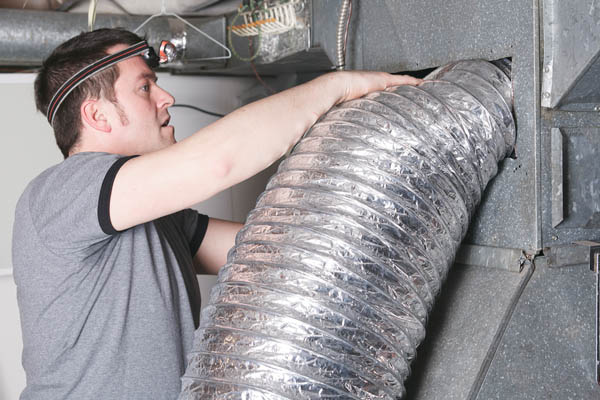Duct Sizing:
When it comes to heating and cooling, duct sizing is absolutely crucial. The heating, ventilation, and air conditioning system has to work more to keep the house at a specific temperature if the ducts are too small. On the contrary, insufficient air distribution and uneven heating or cooling can occur if the ducts are too large, which reduces air velocity. It is possible to reduce energy consumption and increase comfort by properly sizing ducts according to the needs of each room.
Duct Layout and Configuration:
The effectiveness of heating and cooling is greatly affected by the design and arrangement of ductwork. Duct lines should be as short as possible, with as few turns and bends as possible, and any obstacles that could restrict airflow avoided. Reduced resistance and pressure drop are results of air flowing smoothly via straight, clear ducts. Balanced airflow throughout the building can be achieved by carefully placing supply and return ducts. This will ensure that all regions are consistently heated or cooled.
Insulation:
Sufficient duct insulation is necessary to stop energy loss and keep the temperature constant. Particularly in unconditioned areas like basements, crawl spaces, or attics, ducts that are not insulated or have inadequate insulation can cause a substantial loss of conditioned air by conduction. Duct insulation improves system performance and lowers energy costs by limiting heat gain in summer and heat loss in winter.
Air Leakage:
A common issue with duct systems is air leakage, which can have a major influence on the efficiency of heating and cooling. Wasted energy and decreased system performance can result from duct leaks, which allow conditioned air to escape into unconditioned regions. Preventing air leakage and improving overall system efficiency can be achieved by sealing duct joints, connections, and gaps with the right materials, like mastic or metal tape. In order to find and fix leaks quickly, routine inspections and maintenance are required.
Duct Material:
Heating and cooling efficiency can be affected by the material of the ducts. Fabricated ducts are often made of flexible ducting, fiberglass, or sheet metal. Due to their low airflow resistance and long lifespan, sheet metal ducts are an excellent choice for systems operating at high speeds. Though they insulate well against heat, fiberglass ducts can let air out if not sealed correctly. Although flexible ducting is convenient and easy to set up, it can limit airflow when compressed or bent. To maximize efficiency, it is critical to choose the right duct material according to the needs of the HVAC system and the building’s design.
Air Distribution:
When it comes to indoor comfort and temperature uniformity, efficient air dispersion is essential. If the ductwork is well-designed, the conditioned air will be distributed evenly throughout the structure, without any hot or cold zones. The use of registers, diffusers, and dampers to regulate the direction and velocity of air may be required for this. To achieve peak efficiency and performance, it is important to balance the airflow in the supply and return ducts.
Duct Design Considerations for Zoned Systems:
The duct design of a building with a zones HVAC system must take into account the variations in temperature needs throughout the various zones. In order to control the airflow and keep each zone in equilibrium, dampers and bypass ducts may be used. In order to avoid wasting energy heating or cooling the entire building, it is important to use zoning and duct design correctly so that conditioned air is sent exclusively to the occupied sections.
Return Air Pathways:
Heating and cooling efficiency are greatly affected by return air paths, which are just as important as supply ducts. It is the job of the return ducts to return conditioned air to the HVAC system. It’s critical to put return ducts in the right places and make sure they’re big enough to draw air from everywhere in the building. To maximize airflow and system efficiency, return grilles should be placed in core areas and kept clear of obstacles like curtains and furniture.
Duct Pressure and Airflow Balancing:
Maintaining a constant performance and comfortable inside climate requires careful regulation of duct pressure and airflow. If the airflow in the supply and return ducts is not evenly distributed, problems like pressurization and depressurization—which can cause air leakage or discomfort—could arise. To improve system efficiency and indoor comfort, balancing dampers, variable-speed fans, and airflow measurement devices can be used to ensure appropriate airflow distribution and pressure balancing.
Duct Design for Humidity Control:
Duct design affects humidity levels in a building just as much as temperature management. The distribution of conditioned air, which affects indoor humidity levels, can be improved with properly sized and designed ductwork. Inadequate airflow or supply registers placed incorrectly, for instance, might cause an uneven distribution of humidity, which in turn can cause problems like dry air pockets or moisture buildup. Maintaining interior humidity levels within healthy and acceptable limits is made possible by designing duct systems to ensure balanced airflow and temperature distribution.
Duct Design for Noise Reduction:
Indoor noise levels are also affected by ducting design. Occupants may find the noise produced by air rushing through ducts or vibrating duct materials to be bothersome. Making sure ducts are appropriately sized to maintain adequate air velocities and using vibration-dampening materials to reduce noise from duct components are two ways to minimize noise transmission. To further reduce noise transmission and enhance indoor comfort, ductwork should be placed away from noise-sensitive areas or sound-absorbing insulation can be used.


